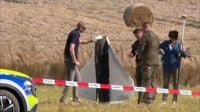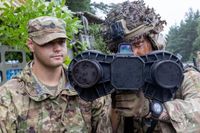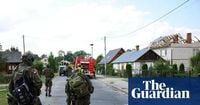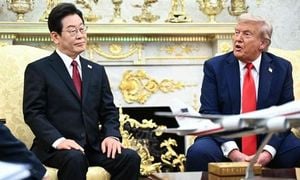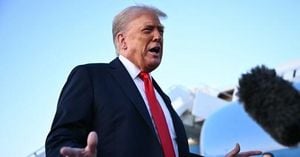In the dead of night between September 9 and 10, 2025, the skies over Poland were pierced by the whine of Russian drones—at least 19 of them, according to Polish officials, in what authorities have described as an unprecedented act of aggression. The Polish military managed to shoot down at least three, but the sheer scale and coordination of the incursion marked a dramatic escalation in the ongoing standoff between Russia and NATO’s eastern flank. The episode, which followed on the heels of a daring Russian naval drone strike in the Danube Delta, has left Europe’s security establishment rattled and searching for answers.
Polish Prime Minister Donald Tusk did not mince words, calling the airspace violations a “real threat to the safety of our citizens.” The country’s military command labeled the incident “unprecedented,” a sentiment echoed by defense officials across the region. NATO’s eastern members—Lithuania, Latvia, Estonia, Romania, and now Poland—have all experienced similar airspace violations in 2025, suggesting that these are not isolated mishaps but part of a broader, calculated campaign by Moscow.
According to ABC News, the Polish military accused Moscow of an “act of aggression,” while European Union foreign affairs chief Kaja Kallas asserted that these incursions appeared “intentional, not accidental.” The question on everyone’s mind: Is Russia testing the resolve and capabilities of NATO’s eastern members, or are these the inevitable byproducts of a chaotic, technology-driven war on Ukraine’s doorstep?
For Lithuania, the answer is clear. Defense Minister Dovile Sakaliene told ABC News that the country has changed its procedures, deployed additional forces, and is now “ready to shoot it down” should another drone cross its border. Lithuania even closed its airspace along the Belarusian border until October 1, coinciding with joint Russian-Belarusian military exercises. “This is not just Lithuanian airspace, not just Lithuania's security—it is NATO airspace, NATO security and also EU security,” said Lithuanian Foreign Minister Kestutis Budrys, highlighting the regional stakes.
But the threat is not limited to the air. On September 10, a Russian naval drone struck the Ukrainian intelligence vessel Simferopol in the Danube Delta, just 200 meters from the Romanian border. The attack, which was filmed and publicly released by Russia, showcased Moscow’s growing prowess in unmanned naval warfare. Glen Howard, Chairman of The Saratoga Foundation, described the strike as “carefully well-planned,” while George Scutaru, a former Romanian National Security Advisor, warned that Russia’s willingness to use drones in such a sensitive area raises concerns about potential false-flag operations against NATO assets.
The Danube is no ordinary waterway. It is a vital artery for Ukrainian grain exports and a key economic corridor for Romania, which is projected to become the European Union’s largest gas producer by 2027. The use of naval drones in the Danube signals a willingness by Moscow to escalate not just on land or in the air, but also in Europe’s most strategic rivers and seas. As Dr. Steven Wills of the Center for Maritime Strategy put it, these events are a “wake-up call for NATO,” exposing vulnerabilities in areas not traditionally covered by Article 5, the alliance’s mutual defense clause.
Admiral Ihor Kabanenko (ret.), a former Ukrainian Deputy Defense Minister, noted that while Ukraine pioneered naval drone warfare, Russia has caught up quickly. The July 2025 “July Storm” exercises in the Baltic Sea saw Russia deploy new strike drones, signaling that the threat could soon extend to the Baltic and beyond. “Any vessel over 50 meters long is now a vulnerable target in the Black Sea,” warned Ukrainian Navy Captain Andrii Ryzhenko (ret.), who advocates for a “mosquito fleet” of small, nimble vessels to counter the drone threat.
Back in the air, the Polish incursion briefly shut down major airports and prompted Warsaw to invoke NATO’s Article 4, signaling that its territorial integrity was under direct threat. This is a rare move, stopping short of the full mutual defense trigger but leading to urgent consultations among allies. According to the Atlantic Council, NATO responded with a multinational force: Polish and Dutch F-35s and a German Patriot air defense system were deployed, marking the first time NATO directly engaged Russian objects in allied airspace.
Daniel Fried, former US ambassador to Poland, argued that Russia is trying to spread a “gray zone” of insecurity as far west as possible. Ian Brzezinski, a former US deputy secretary of defense, described the drone barrage as an intentional challenge to the will of Western democracies. He called for a two-pronged response: harsh sanctions to “body slam” the Russian economy and reinforced military presence in frontline states. “The softer the reaction, the harder the next blow will be,” warned Oksana Nechyporenko of the Atlantic Council’s Eurasia Center, echoing a common saying among Ukrainians.
Yet, the practical challenges of defending against cheap, mass-produced drones are daunting. Estimates put the cost of Russia’s Shahed and Geran drones between $10,000 and $100,000 each, with Gerbera decoy drones at around $10,000. In contrast, shooting them down with US-made Patriot missiles—at $4 million apiece—or even IRIS-T interceptors at $470,000, is simply unsustainable. Kusti Salm, former permanent secretary at Estonia’s Defense Ministry, told ABC News that the “cost to kill ratio discrepancy” is “so strongly in favor of Russia.”
Russia, according to the Atlantic Council, is now producing about 5,000 long-range drones each month. NATO nations, meanwhile, lack the radar coverage, anti-air weapons, and manpower to ensure comprehensive protection. Estonia, for example, has procured IRIS-T systems and radars to form a multi-layer air defense, but as Salm put it, “there is no silver bullet yet.”
Poland, for its part, is responding with resolve. As Piotr Arak of the University of Warsaw highlighted, the country plans to spend a staggering 4.8% of its GDP on defense in 2025—the highest in NATO. This investment is modernizing its military and solidifying its role as a key pillar of European security.
The recent incidents have also prompted calls for increased economic pressure on Russia. Daniel Tannebaum of the Atlantic Council advocates for secondary sanctions that would force countries like China and India to choose between Russia and the more lucrative US and European markets.
For now, NATO and its eastern members are racing to update legislation, deploy forces, and adapt their defenses to this new era of warfare—one where the threat is not just from tanks or jets, but from swarms of cheap, hard-to-detect drones in the air, on the water, and perhaps soon, everywhere in between. The unity and speed of the response will be crucial. As the events of September 2025 have made clear, the stakes could not be higher—and the next test may come sooner than anyone expects.
